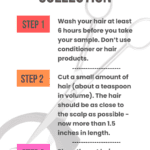Hair Tissue Mineral Analysis (HTMA)
Hair Tissue Mineral Analysis (HTMA) is a safe and non-invasive screening test that gives a comprehensive insight into the mineral content in your body. It involves testing a small sample of hair from your scalp to identify the presence and concentrations of various life-giving minerals and harmful heavy metals, like lead, mercury, cadmium, arsenic, and aluminum. This information can help evaluate your nutritional status and metabolism. An HTMA test also checks for heavy metal toxicity, offering a blueprint for improving overall health and wellness. After your pracitioner receives your hair analysis test, they should read it for you, clearly explain the results, as well as develop a plan of action that might include some diet changes and targeted supplements that will help to balance your minerals.
Heavy Metal Levels Found on an HTMA Test
Hair testing is vital in assessing our body’s exposure to heavy metals over time. These harmful metals have NO biological function in the body. They simply don’t belong. When they accumulate in the body, they can turn into serious health problems. The HTMA test helps to detect these toxic metals, allowing for early intervention and treatment.
Heavy metal accumulation in our bodies is an often overlooked health risk. It can occur through numerous routes, such as through the food we eat, the water we drink, or even the air we breathe.

By enabling us to monitor the levels of harmful metals in our bodies, hair testing serves as an invaluable tool for maintaining our vitality. This test not only provides a snapshot of our current exposure to heavy metals but also provides a record of our levels over time.
It is this long-term view that makes a hair analysis test a powerful resource for managing our health, enabling us to identify trends, anticipate potential risks, and take proactive steps to promote our well-being.
Health Issues Caused by Heavy Metals
There is a wide variety of health symptoms and conditions associated with all of the heavy metals. The graphic below is absolutely not an exhaustive list. There are numerous more toxic metals as well as many more negative issues linked to them. Please keep that in as mind as you consider the dangers of these heavy metals and how they may be affecting your health.
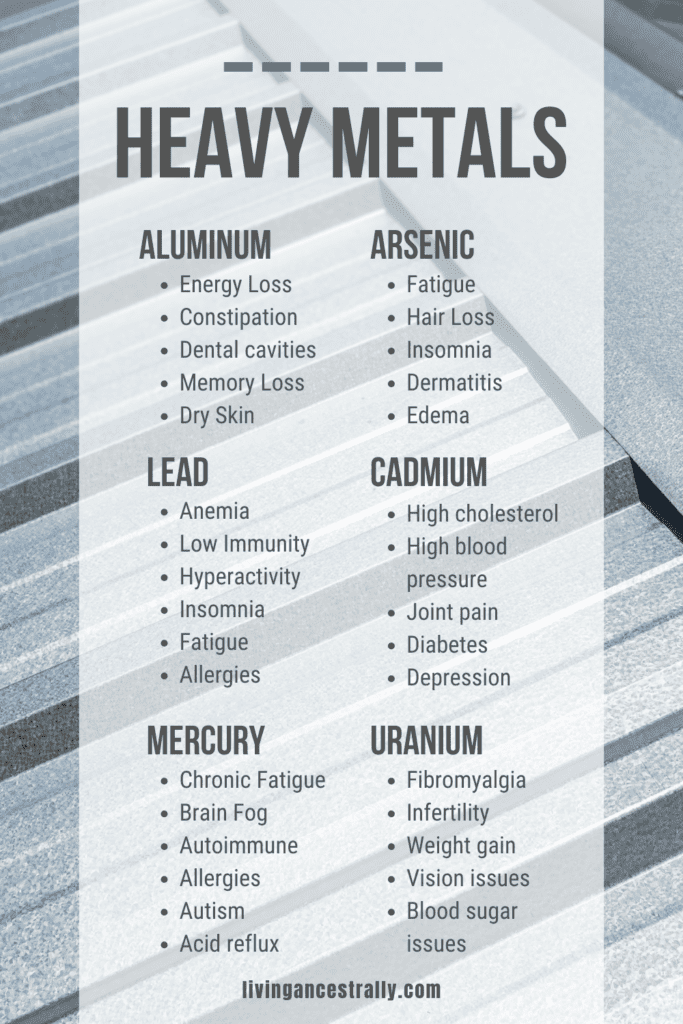
HTMA: A Functional Health Practitioner's Viewpoint
The hair tissue mineral analysis test sure is a life-saver, as well as a life-giving tool. At least that’s what I’ve come to realize.
As a functional health practitioner and mother, I can attest to the damage caused by heavy metals. I have a few adolescent clients who have major health issues due to these toxins. These harmful metals have an extremely negative impact on our vital organs and may impact a child’s growth and development.
From a mother’s perspective, I cannot emphasize just how important it is to know what mineral imbalances children have, as well as which heavy metals are accumulating in their bodies.
My own child was dealing with some heavy metal toxicity for longer than I know. A chronic rash, behavior challenges, and early-life sleep issues should have clued me in, but I was clearly unaware for way too long. Unfortunately, this type of situation applies to way more parents than we realize.

It can be very helpful for children to get an annual HTMA test as a preventative tool to ensure their nutrient levels are adequate and they aren’t dealing with more heavy metals than we realize.
Before we dive more into learning more about hair analysis testing, let’s first learn more about minerals and why they are important.
Why Minerals?
Minerals, in essence, are the spark plugs of life. They play a crucial role in our bodies, ensuring that we are operating on all cylinders.
Think about it this way – our bodies are like complex machines that need a variety of components to function smoothly. Just as a car needs oil, our bodies need minerals to ensure everything runs as smoothly as possible.
Take calcium, for instance. It’s not only essential for strong bones and teeth, but it also plays a vital role in blood clotting, muscle function, and even thyroid function.

Or consider iron, which is integral in the process of making proteins and red blood cells. Without these minerals, our bodies would struggle to perform these fundamental tasks, and that’s not something we want, is it?
The bottom line is, that minerals are critical to our well-being. They help our bodies perform vital functions from using vitamins more efficiently to building strong bones to transmitting nerve impulses.
On the flip side, our mineral ratios can also become imbalanced (too high or too low) and cause a lot of health issues. One really good example of this is the zinc/copper ratio. I’ve written about how harmful it is to have this ratio imbalanced. Really though, if ANY of the mineral ratios are imbalanced then health issues are very common.
Why Not Just Test the Blood?
While it may seem logical to test blood for chronic mineral and heavy metal levels, it’s not necessarily the most effective method.
Here’s why. Blood is a transport medium in the body, carrying nutrients and substances to where they’re needed.
Consequently, the blood composition changes quite rapidly depending on numerous factors like time of day, meals, and even your emotional state.
The surge and drop in mineral concentration in the blood makes it a less reliable measure of long-term mineral status and heavy metal toxicity.
Now, let’s compare that to hair tissue…
Hair growth is a metabolic process, and as our hair grows, it locks in a sort of “historical record” of our mineral status and heavy metal load over time. Unlike blood, it’s not subject to the same rapid fluctuations, making it a more reliable source for understanding our body’s accumulation of minerals and harmful metals.
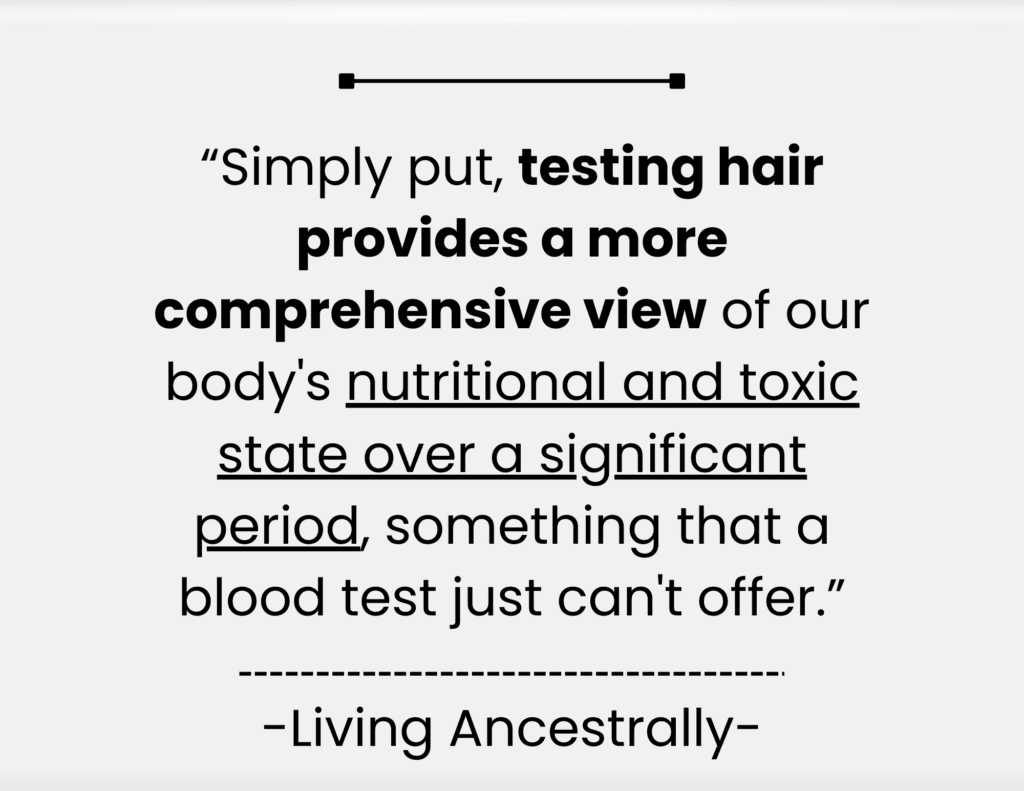
Discover Why the Body Unloads Excess Minerals in Human Hair
You might find it fascinating to learn that our bodies are quite clever when it comes to maintaining balance. The human body has its own ingenious methods of self-regulation, and one of these methods involves the disposal of minerals it doesn’t need.
But where do these minerals go? Well, one of the places is our hair.
Picture your hair as a kind of waste management system. When there’s an overabundance of minerals in your body, it starts looking for places to offload the excess. Your hair is just one of the routes it uses.
As the hair forms and grows, these extra minerals get incorporated into the hair protein structure, effectively getting them out of circulation.
Now, you might be wondering, why hair?
Well, it relates back to our body’s resourcefulness. Hair is a non-essential tissue, meaning our bodies can afford to use it this way without causing any harm to our vital functions.
In a nutshell, by offloading excess minerals into our hair, our bodies can maintain their balance and keep running smoothly. It’s a pretty neat trick, don’t you think?
Why Test for Minerals and Heavy Metals Using Hair Samples?
Testing for minerals and heavy metals using HTMA is not just useful, it’s truly insightful.
You see, the beauty of hair testing lies in its ability to provide a more comprehensive, long-term view of what’s happening inside our bodies. It’s akin to a deep dive into our internal world, revealing the presence and accumulation of both beneficial minerals and potentially harmful metals.
This knowledge isn’t just cool science; it’s an empowering tool that can guide us in making informed decisions about our well-being.

Let’s break it down a bit further…
As already mentioned, minerals are the spark plugs that keep our bodies running smoothly, while heavy metals, in excess, can act as spanners in the works, disrupting our systems. HTMA tests help us keep tabs on both. We can monitor whether we’re getting enough of those essential spark plugs and ensure that those pesky spanners aren’t causing havoc.
It’s like having a health surveillance system right at our fingertips. HTMA tests can be a game-changer when it comes to taking control of our health and wellness.
Is Hair Testing Based on Science?
Hair Tissue Mineral Analysis (HTMA) is a method that’s grounded in scientific principles and has been utilized for several decades. It came into the medical field’s attention in the late 20th century as a potential means to measure the levels of essential and toxic elements in the body.
The science behind it involves the notion that hair, due to its metabolic activities, can accumulate and reflect the body’s mineral status over an extended period.
In practice, hair analysis testing has been used in various fields including forensic medicine, nutritional therapy, and environmental health.
It’s also favored in certain cases due to its non-invasive nature, ease of collection, and storage. However, while HTMA is backed by science, it’s crucial to note that its interpretation should be handled cautiously.
Factors like hair treatment such as hair dyes, beauty products, and environmental exposure can potentially affect the results, making it essential to consider these variables when interpreting the data.
What All Can We Learn From the HTMA Test?
Hair mineral testing is a powerful tool that provides a unique perspective on our bodies’ inner workings, specifically concerning mineral imbalances and heavy metal toxicity.
The hair analysis test evaluates the mineral levels in our hair, offering an understanding of the body’s biochemistry, including information about metabolic rate, energy levels, sugar and carbohydrate tolerance, immune system, glandular activity, and more.
The test comprehensively examines levels of approximately 15 essential minerals such as calcium, magnesium, sodium, potassium, iron, copper, and zinc, to name just a few. It also tests for crucial trace minerals and toxic elements. The toxic elements category includes about 8 heavy metals like lead, cadmium, arsenic, and aluminum.
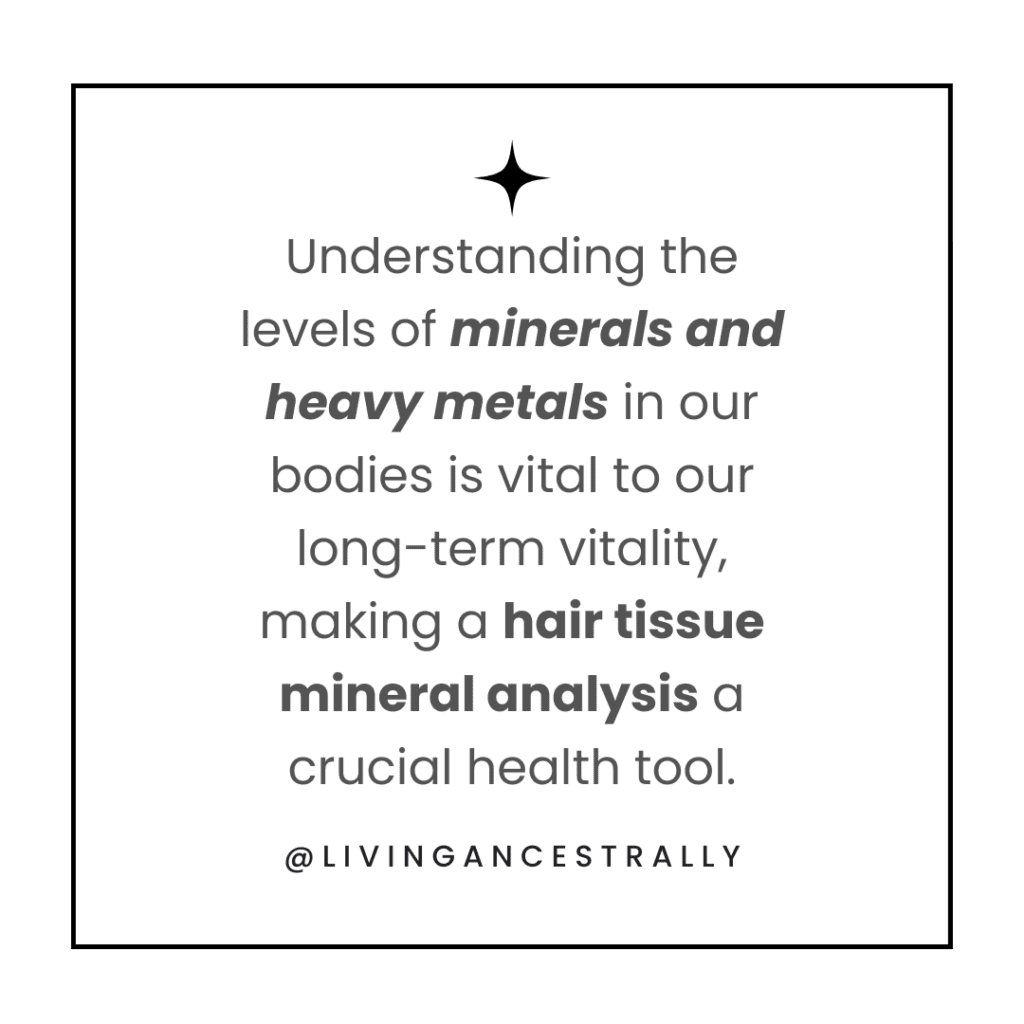
Imbalances or deficiencies in these minerals can turn into metabolic abnormalities that may cause a variety of health issues, including hormonal imbalances, nervous system disorders, and cardiovascular diseases.
Overall, hair analysis provides a foundation for a personalized and effective nutritional program. By knowing our mineral imbalances and toxicities, we can address our unique needs better and adjust our diet and lifestyle accordingly, promoting optimal health and well-being.
It's Important to Understand that HTMA is not a Diagnostic Test
Even though a hair analysis test is an exceptional tool for understanding the mineral content within our bodies, it’s important to remember it is not a diagnostic test.
Rather than pinpointing a particular disease or condition, the HTMA offers insight into the mineral deficiencies and heavy metal toxicities that exist within our bodies.
By doing so, we’re not merely reacting to disease but actively working to create a bodily environment that is less likely to succumb to disease in the first place. It’s like a health check-up for your mineral balance, helping us to stay one step ahead of potential health concerns.
With that being said, if you address your imbalances as well as your heavy metal load, it’s possible for your negative health conditions or symptoms to improve with continued effort.
How to Collect Hair Samples for the Lab
Collecting a hair sample for the hair tissue mineral analysis test is as easy as 1-2-3. There’s no need for any complicated tools or a trip to the doctor’s office. You can do it right at home, and it only takes a few minutes. Plus, it’s pain-free, so you won’t have to worry about the discomfort associated with blood tests.
PIN FOR LATER
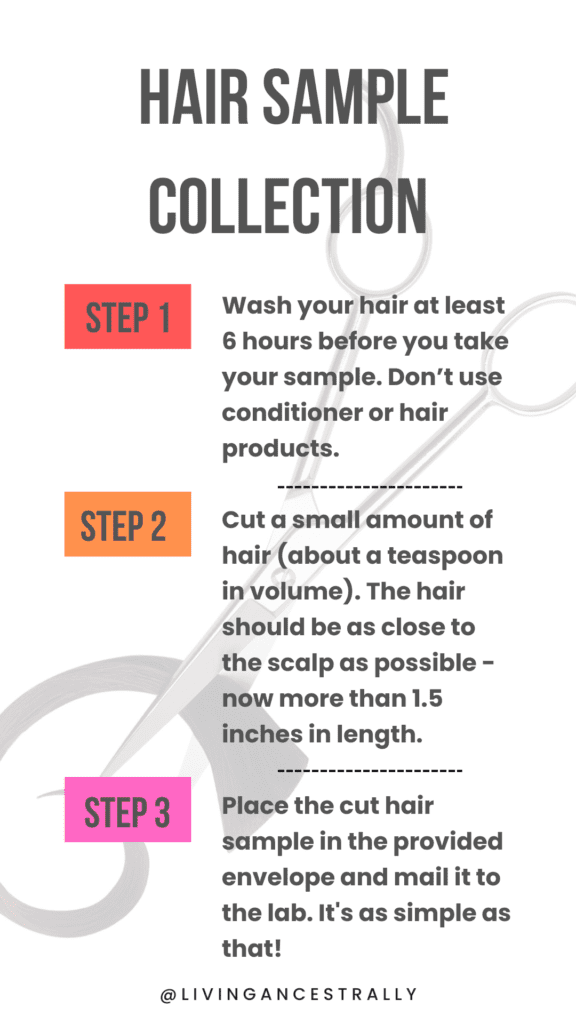
Here are some more detailed instructions:
✔️ Step 1: Make sure your hair is clean and free of any hair products. It’s best to wash your hair and let it dry naturally before you collect the sample.
✔️ Step 2: Using stainless steel scissors or cutting shears, cut a small amount of hair (about a teaspoon in volume) from the nape of your neck. The hair should be as close to the scalp as possible because it’s essential to collect NEW hair growth. Collect samples from 3-4 different spots at your hairline.
✔️ Step 3: Place the cut hair sample in the provided envelope or bag, fill out the provided form, and mail it back to the lab in the provided prepaid envelope. It’s as simple as that!
Be sure to check with your practitioner for more information on how to collect a high-quality hair sample for the lab. They should have even more clear and concise directions. For my functional health clients, I always provide them with a detailed video, as well as thorough written instructions so that the process is as smooth as possible for them.
How To Order an HTMA Test
If you’re thinking about ordering a hair mineral analysis test, the process is pretty straightforward…
First, you’ll need to connect with an alternative practitioner who offers this type of testing. It’s really crucial to find someone who’s not just experienced, but also highly knowledgeable—to properly interpret your results and guide you through the process.
Remember, you’re not just after the raw data from the lab report.

I highly recommend you choose an HTMA practitioner who offers ongoing support for several months because there is a high likelihood you will need it. Your practitioner can help you troubleshoot challenges you may experience as you address the imbalances and heavy metals that are found on your hair mineral test. The goal should always be to get you better so that you don’t need help forever.
So, do your research and find a practitioner who can offer you this level of detailed attention and is willing to figure out the puzzle pieces that have been troubling you for years—it really is worth the extra effort!
Also, be sure to choose a practitioner that uses either Trace Elements Lab or Analytical Research Labs. These labs are highly regarded in the hair testing space. They don’t wash the hair samples after they get them, unlike other labs. Not washing the hair sample is crucial for accurate results.
As a hair mineral practitioner, I’d like to see if you are a good fit for my program. Feel free to click on my program link below to learn more.
Please note that A Hair Mineral Analysis (HTMA) is not intended to diagnose, treat, cure, reverse, or prevent any disease. It is not intended to replace any other medical test(s) that may be prescribed by your medical doctor.


